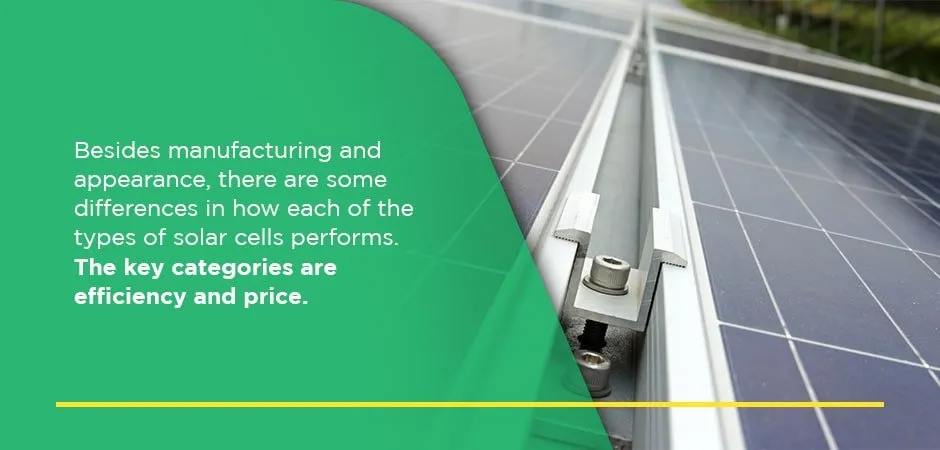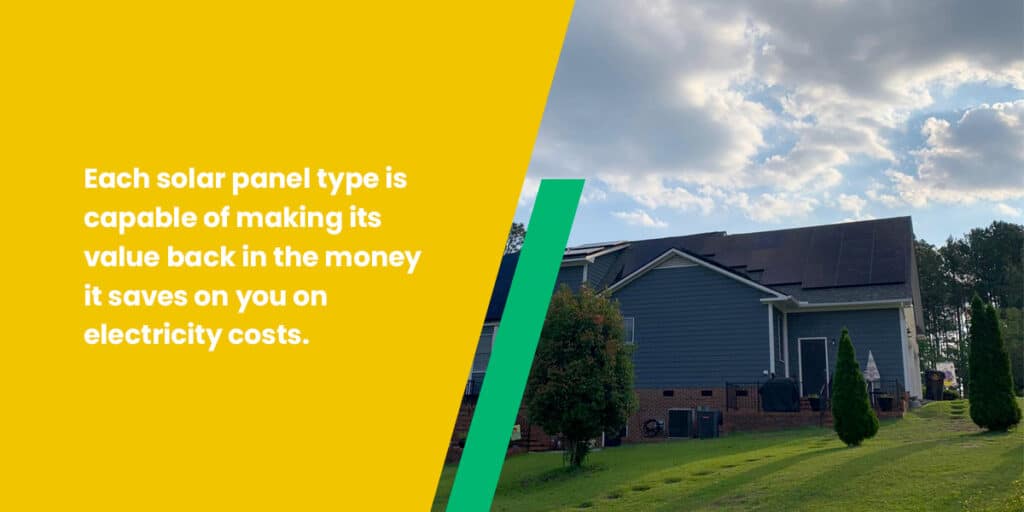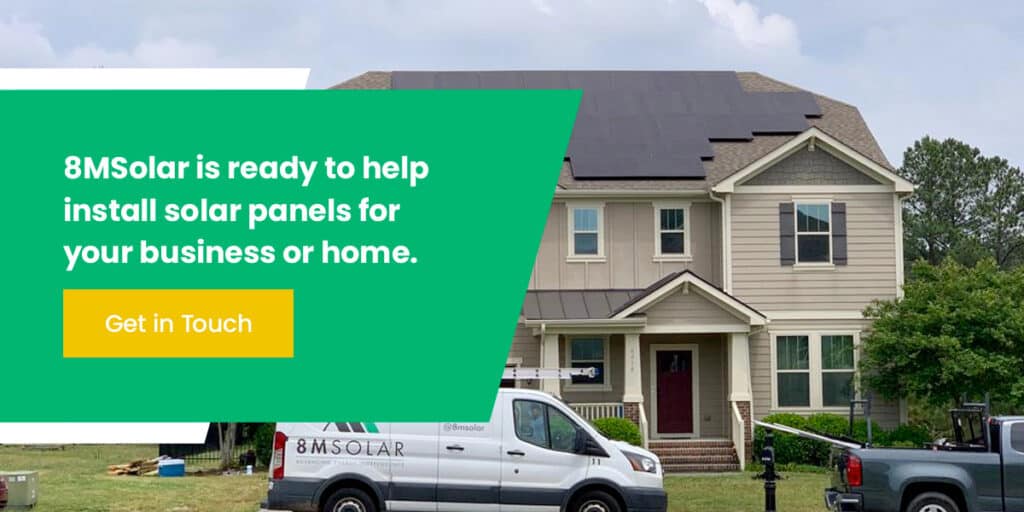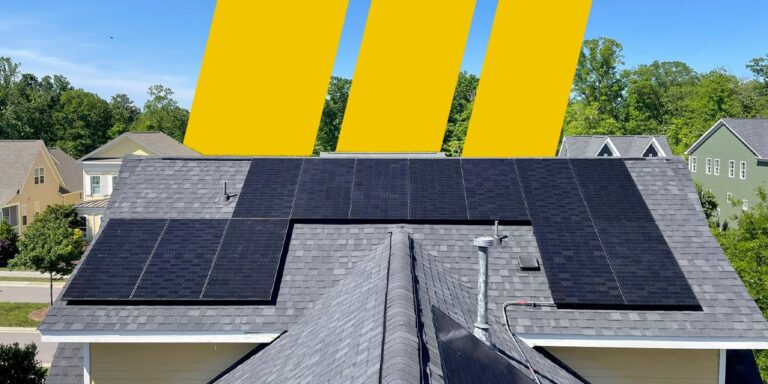Solar panel installation offers many advantages for your home, such as lower electricity bills, energy independence and clean energy. When you are considering adding solar panels, you have to think about different factors such as energy efficiency, appearance and costs. These are essential factors and will play a large part in your decision. One of the most important aspects of buying solar panels is the type of solar panels you choose to buy.
Ultimately, your specific situation and what you wish to achieve will determine which solar panel is right for you. This helpful guide will outline the different types of solar panels, their benefits and how to pick the best solar panels for you.
Key Points
- The three types of solar panels are Monocrystalline (efficient, expensive), Polycrystalline (budget-friendly), and Thin-Film (versatile, shortest lifespan).
- Monocrystalline panels are most efficient, thin-film are least expensive, with polycrystalline panels balancing both aspects.
- Lifespans of panels vary by type (monocrystalline longest, thin-film shortest). Other factors include temperature coefficient, fire and hail resistance.
- Selection depends on location and space. Polycrystalline for large residential roofs, monocrystalline for small spaces, thin-film for commercial use.
- The top solar brands include Q Cells, Solaria, and REC Group for their quality, warranties, and support.
- 8MSolar offers expertise in installation, quality products, and tailored solutions for both residential and commercial customers.

What Are the Three Types of Solar Panels and What Are They Made of?
The three different types of solar panels are thin-film, polycrystalline and monocrystalline solar panels. Each of these types of solar cells is made in a unique way and has a different aesthetic appearance. Here is the breakdown for each type of solar panel.
1. Monocrystalline Solar Panels

Monocrystalline solar panels are the most developed of the three types of solar panels. Monocrystalline solar cells made from pure silicon create this type of panel. Because of their manufacturing process, these panels are likely to be the most expensive on the market.
This process is known as the Czochralski method. During this process, a silicon crystal is set in a vat of molten silicon. From there, a professional will extract the crystal carefully and slowly, so the molten silicon can harden into a crystal shell called an ingot. This ingot is sliced into thin silicon wafers which are turned into a cell. These cells are organized to make a solar panel.
Once fully formed, the monocrystalline cells resemble squares without corners, leaving small gaps in between cells. These types of solar cells will appear black because of the pure silicon in them, though you will be able to choose from a variety of colors for the frames and back sheets.
2. Polycrystalline Solar Panels

Because of their efficiency, polycrystalline solar panels are gaining in popularity. Though they still use silicon-like monocrystalline solar panels, polycrystalline cells are made from a newer process. Using silicon fragments rather than one silicon crystal makes these panels more budget-friendly.
In this manufacturing method, fragments of a silicon crystal melt together in a vat of molten silicon. Rather than extracting the crystal slowly, professionals will leave it to cool and fragment. After cooling in its mold, the silicon is sliced into polycrystalline solar wafers, which are then organized to create a panel.
When sunlight reflects on polycrystalline crystals, the cells will appear blue in color. Different from pure silicon, which appears black in the sunlight, fragmented silicon will give a lighter, more bluish tinge. Polycrystalline panels are square-shaped and devoid of gaps between them. Frames will typically come in silver.
3. Thin-Film Solar Panels

This is the newest type of solar panel. It stands as the most versatile of the three types because of its unique flexibility and process — instead of only relying on silicon, thin-film solar panels can be made from various materials, such as copper indium gallium selenide (CIGS), cadmium telluride (CdTe) and amorphous silicon (a-Si).
In this process, the material is set between thin sheets of conductive material with a top layer of glass serving as protection. The a-Si panels use non-crystalline silicon topped with glass.
You can easily identify this type of solar panel because of its thin appearance — thin-film panels are approximately 350 times thinner than solar panels made from silicon wafers. Still, the frames of thin-film solar panels can still be large and resemble that of the other two types. The colors of these panels will depend on the material used but will usually be black or blue.

What Does Each Solar Panel Look Like?
Monocrystalline panels are typically black due to how light interacts with the silicon crystal. Although you can find different colors for the back panels, they will typically be white, silver or black with either silver or black frames.
Polycrystalline panels appear blue as the light reflects from the silicon fragments. You can also find different colors for the back sheets and frames, but you will most often see silver or white back sheets with silver frames.
Thin-film panels have a different aesthetic than the previous two types. These panels are slimmer and can create a different look for your property compared to the other two. Depending on the panels’ materials, thin-film systems will likely appear in black or blue hues.
Comparing the Three Types of Solar Panels
Besides manufacturing and appearance, there are some differences in how each of the types of solar cells performs. The key categories are efficiency and price. Here is how each type of solar panel performs in efficiency and affordability as well as other factors to consider.
Efficiency
Efficiency is how much energy the different solar panel types can produce from the amount of sunlight it receives. Essentially, efficiency determines how much power a solar panel can produce. There are many things you can do to increase your solar panel efficiency, but some solar panels are designed to be more efficient from the beginning. The most efficient solar panel is the monocrystalline solar panel.
Monocrystalline solar panels can reach over 20% efficiency. These panels have a high capacity, with most capable of providing more than 300 watts and some exceeding 400 watts. On the other hand, polycrystalline panels can usually only reach 13%-16% efficiency. This gap between the two panels may be closing in the future as technology improves to make polycrystalline panels more efficient.
Thin-film usually offers efficiency hovering between 7% and 18%. The power capacity of a thin-film panel can vary though because there is no standard size, and some models could produce more power than others.
Cost
Price can make or break a solar decision, and the types of solar cells you choose are one of the factors that affect the price the most. The cheapest solar panels are thin-film panels because they can be manufactured at the lowest cost. The CdTe are the cheapest solar panels on the market, but the CIGS can be more expensive.
Thin-film frames are usually lighter, so you can often save on installation costs. On the other hand, monocrystalline is the most expensive solar panel option right now. Manufacturing pure silicon can be expensive, and the panels and frames are heavy, leading to higher installation costs.
Polycrystalline panels were developed to reduce the cost of solar panels, and they are usually more affordable than monocrystalline. But this gap between monocrystalline and polycrystalline panels may close as innovators discover more efficient ways to manufacture monocrystalline solar cells. Keep in mind that on top of solar panel costs, there are often installation costs and monitoring costs as well.
Pros and Cons of Each Type of Solar Panel
| Solar Panel Type | Advantages | Disadvantages |
| Monocrystalline | High efficiency and performance | Higher costs |
| Polycrystalline | Lower costs | Lower efficiency and performance |
| Thin-film | Portable and flexible | Lower efficiency and performance |
Other Factors to Consider for Your Solar Panels
Besides cost and efficiency, there are several other factors to consider when choosing solar panels. Evaluating the life span, temperature coefficient, fire and hail resistance and other considerations will help you determine the best solar panels for your home or business.
Life Span

How long your panels will last will be an essential deciding factor. You want to ensure the panels you choose will stay up and running for as long as possible so you can get the most use out of them.
Monocrystalline panels typically last between 25 and 40 years, while the polycrystalline life span ranges from 20 to 35 years. Thin-film panels offer the shortest life span, typically lasting between 10 and 20 years. The upfront cost of some panels could counteract your long-term commitment and require you to invest more later. However, each solar panel type is capable of making its value back in the money it saves on you on electricity costs.
Temperature Coefficient
One factor is the temperature coefficient. Monocrystalline and polycrystalline solar panels typically have a temperature coefficient of around -0.3% / °C to -0.5% / °C. Thin-film panels have coefficients closer to -0.2% / °C.
What this means is that as the temperature rises, certain types of solar panels will produce more power than others. This is especially important to consider in an area like North Carolina, where the temperature high can be significant.
Fire Resistance, Hail Resistance and Hurricane Rating
Weather conditions are another important aspect to consider when picking the right solar panel system for your home. One important factor to consider is fire rating, which can vary based on the type of roof you have and the type of panel you choose.
- Class A: Class A-rated materials minimize flames to 6 feet and effectively stop fire spread. Many urban areas with wildfire or fire severity risks require this rating.
- Class B: Class B-rated materials are effective at protecting buildings from moderate fires and can prevent flames from exceeding 8 feet.
- Class C: These materials will only protect against light fire exposures and can allow flames to reach as high as 13 feet.
Class A materials will be the best options for protecting your home or business, especially in areas where fires are common or likely to occur.
Fire is not the only natural disaster that can strike your roof, so you will also want to consider hail ratings. Most monocrystalline and polycrystalline panels can withstand 25mm falling at approximately 50 miles per hour, but the exact rating can vary and can affect the life span of your solar system.
Although there is no classification for hurricane rating systems, there are new specifications to safeguard your property from severe weather. Look for panels with the following:
- The highest rating for wind and snow loading in the back and front
- Fasteners with true locking capabilities
- Through-bolting modules rather than clamping fasteners
- 3-frame rail systems for support against twisting and improved rigidity
- Fencing around the system to dampen wind forces
UL and IEC Listings and Other Considerations
You also may want to consider finding heterojunction solar cell technology (HJT) for your system that combines monocrystalline silicon wafers with amorphous silicon. HJT has peak efficiency with the lowest temperature coefficient and no Light Induced Degradation (LID). Finally, you will want to consider LID because degradation of efficiency can affect the amount of energy you are able to produce.
All of these various factors are considered by our engineers when designing and recommending a solar PV system. We look at the overall system life cycle and efficiency not just in ideal scenarios but in all conditions that your solar PV system will be subjected to.
It is a great idea to have a basic understanding of how solar panels work, but we understand it can be overwhelming to choose the proper type of solar panels. Our solar experts at 8MSolar are available to assess your needs and help you make the best decision for your unique needs.

Applications and Installation for Each Type of Solar Panel
Now that you understand some of the defining characteristics of each solar panel, their applications can help you evaluate which one is right for you. You will find the best type of solar panel when you consider the installation locations and the panels’ purpose. For residential properties with a large roof space or property, the best choice of panels may be polycrystalline. These panels are the most affordable for large spaces and will provide enough efficiency and power. For residential properties with smaller spaces, monocrystalline solar panels may be the best choice. These panels work well for those who want to maximize their energy bills in a small space.
Monocrystalline solar panels and polycrystalline solar panels are excellent choices for homes and similar property buildings. Homeowners almost never utilize thin-film solar panels because they are lower in efficiency. Instead, business owners and commercial buildings use thin-film solar panels when they cannot handle the additional weight of traditional panels. Although thin-film is less efficient than the other panel options, commercial buildings have more roof space to cover the surface with panels.
Which Type of Solar Panel Is Best?
Looking through all the various types of solar panels and understanding their unique characteristics will help you narrow down your decision. Still, the best solar panel for you will likely be based on your specific situation — make sure you are taking a look at what you need most so you can choose the best option for you.
Consider some of the core factors involved in the decisions like function, size and cost:
- Function: Consider the main reason you are looking to purchase solar panels. You could be looking for savings on your energy bill or trying to decrease your energy footprint. Figuring out your primary reason for switching to solar can help guide you toward the right choice of solar panels for you.
- Size: Take a look at the surface area and the number of appliances you will want to power. A relatively small, simple home may require a different kind of solar panel than a sprawling house with more extensive amenities.
- Cost: One of the most significant factors you will want to consider when it comes to choosing the right solar panels for you is your budget. While you can still deviate a bit from a certain number, going in with a price range in mind will help keep you on track and allow you to choose the best solar panel for you.
Make sure you are keeping these important characteristics in mind as you shop for solar panels. Although understanding all of the various differences between types and figuring out what you need can be helpful in the process, you may still want some extra help to choose the right product. Be sure to seek out professionals in the industry who can help you find the best product for you.
Best Solar Panels on the Market by Brand
As a design and engineering-based firm we can install any make and model of panels. We constantly and regularly survey our available panel options and determine the best fit for each customer and their situation. That being said, there are typically three leading brands we gravitate towards, due to their company strength, quality of panels, warranty process, and post-installation support.
Qcells
Qcells provides one of the best panels on the market for a great price in the Q.Peak DUO BLK G10+ panel. Qcells has the largest solar panel manufacturing facility in North America located outside of Atlanta, Georgia. We here at 8MSolar believe this is one of the top panel options on the market. Qcell also provides a 25-year power output warranty that guarantees up to 86% power output from your panel in year 25 of the warranty, as well as a 25-year product warranty covering material defects. For more information read our Qcells’ Review.
Solaria
Solaria is a premium panel manufacturer located out of California. They specialize in high-quality residential panels. 8MSolar commonly works with two of its panels, the Solaria PowerX and the Solaria PowerXT. The Solaria PowerX comes with a 25-year warranty, and the Solaria PowerXT comes with a 30-year warranty. – both are excellent options for your home. For more information read our Solaria review.
REC
REC Group is another manufacturer providing excellent premium residential panels. Our two most popular REC panel options are the REC Alpha Pure and the REC N-Peak 3. Both guarantee 92% of year 1 power output in year 25 of their 25-year power output warranty – an industry best. 8MSolar is a REC ProTrust Installer, so our customers are eligible for REC’s extended warranty program! For more information read our REC Review.

Contact 8MSolar
If you are not sure which of the types of solar panels will work best for your project or you want some guidance on understanding solar panel technology, our experts at 8MSolar can help you determine the right panels for your unique project.
At 8MSolar, we offer affordable, effective solar solutions to both residential and commercial customers. From expertise to energy savings, we offer you many advantages:
- Expertise: To ensure there is effective communication, continuous engagement and quality installation throughout the entire process, we assign a local project manager to each of our customers. These project managers have experience in both construction and engineering and know exactly how to install your solar panels the right way. You will be able to have confidence that an experienced professional is taking care of the process.
- Quality products: At 8MSolar, we make sure we are offering our customers the latest and highest-quality products on the market. You will be able to trust the durability and effectiveness of our products. If something goes wrong, our engineers are ready to make immediate repairs.
- Value: We offer unrivaled value that combines high-quality panels with great prices. Even if you are on a budget, you can find a solar panel that will be effective in achieving your energy and savings goals. Our streamlined business model helps us get rid of unnecessary costs so that we can make prices more affordable for our customers.
- Savings: Once your solar panels are installed, you will soon start to see energy savings. Solar panels are an investment in your future that will continue to give you returns.
8MSolar is ready to help install solar panels for your business or home. With expertise, quality products, great prices and savings, 8MSolar is the way to go. Get in touch with us to start finding the right solar panels for you.


